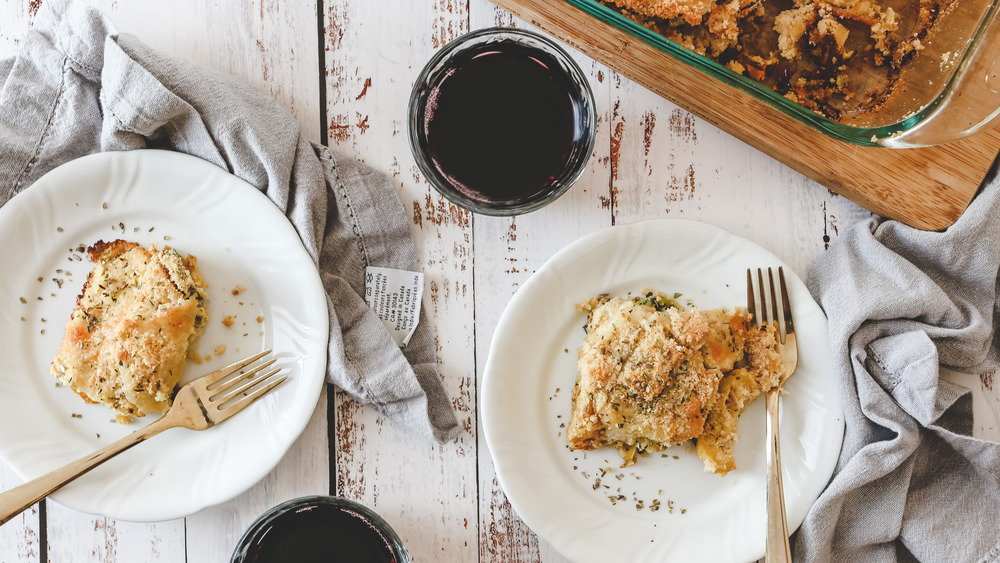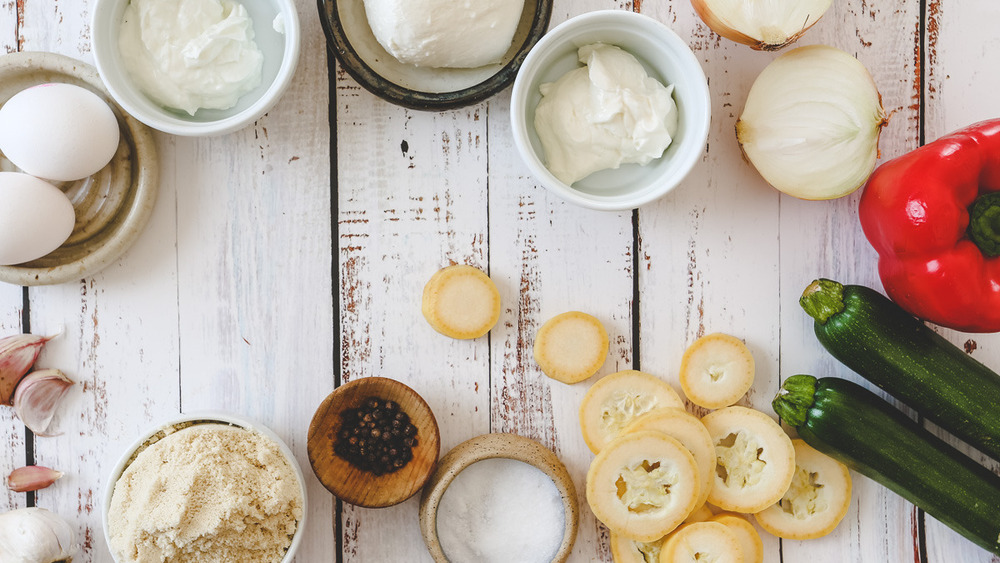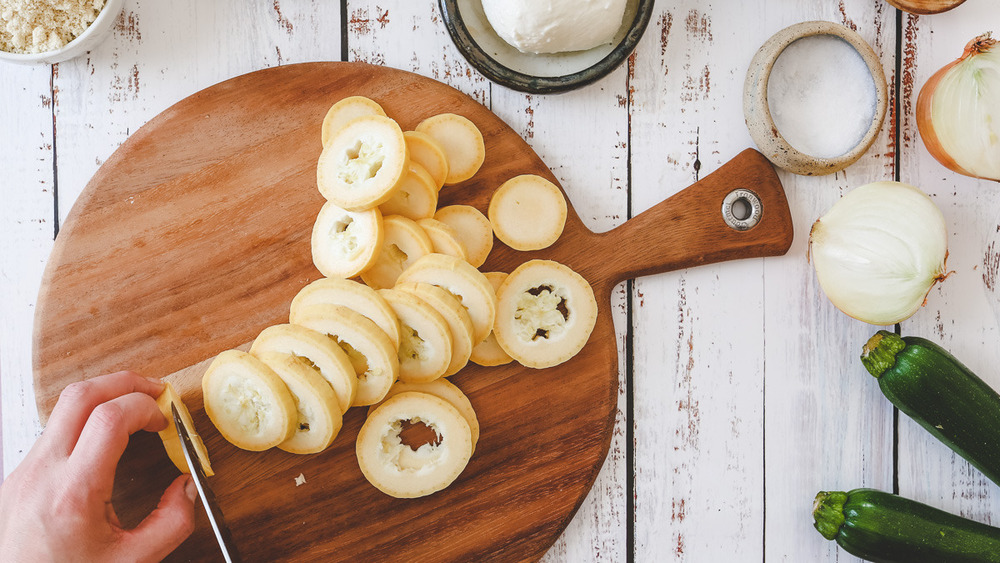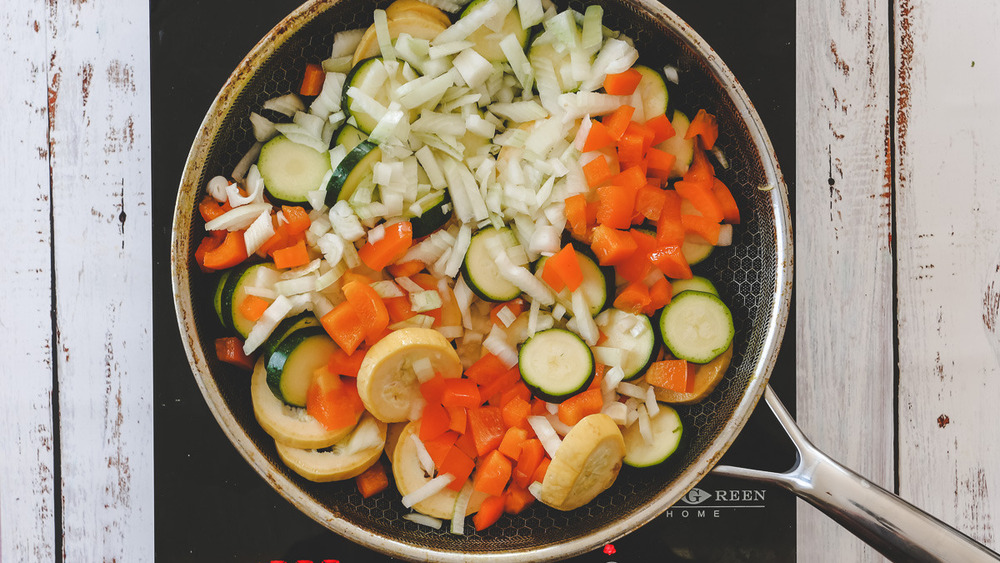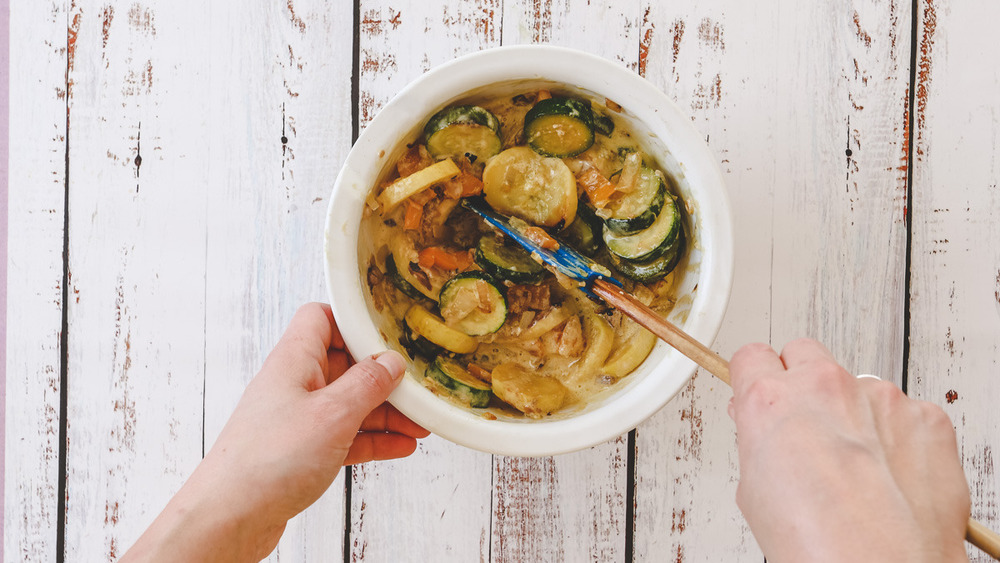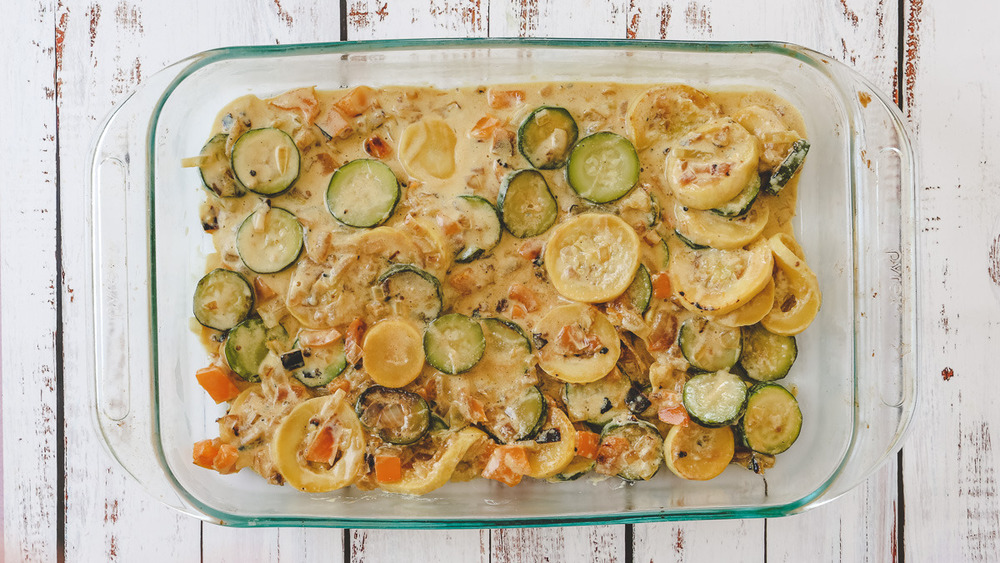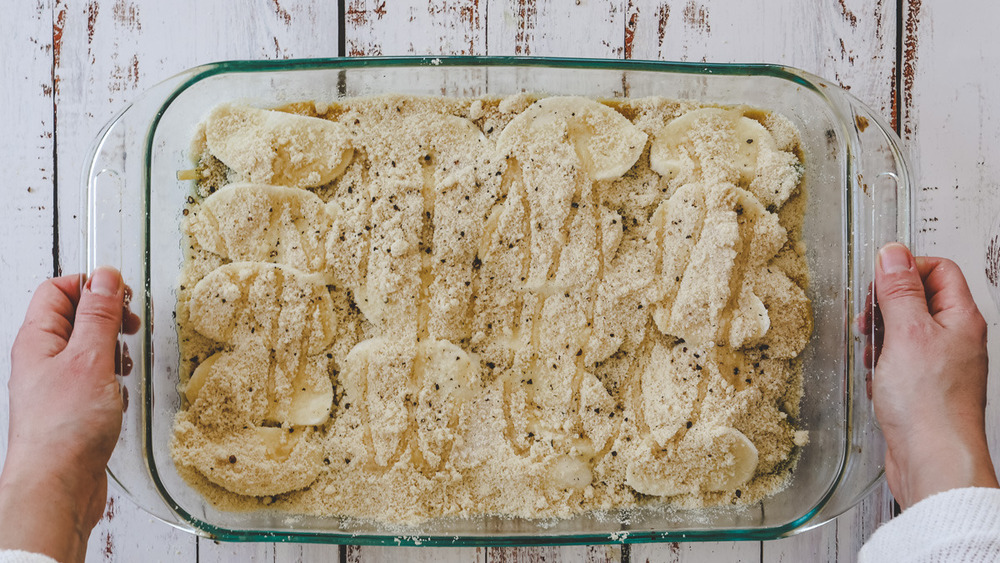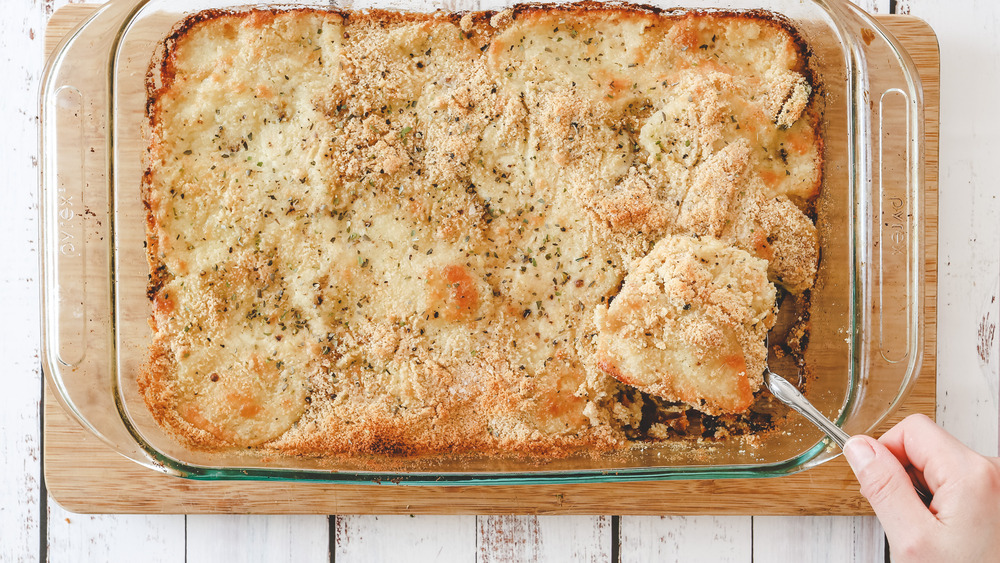Healthy Squash Casserole
This healthy squash casserole with a yogurt and low-fat sour cream filling, topped with fresh mozzarella and a crispy almond crust is such an elegant meal. A squash casserole doesn't have to be loaded with breadcrumbs, butter, and fat to taste good, says food blogger and photographer Ksenia Prints of At the Immigrant's Table. Our squash casserole has all the flavor of its traditional, loaded counterparts, with a fraction of the carbohydrates and fat. The unexpected bonus is that it looks and tastes especially luxurious.
Delicate yellow squash and sliced red bell peppers are topped with fresh mozzarella cheese and an almond "breadcrumb" coating. The resulting casserole is a beautiful, monochromatic layering of yellow and white colors that looks like it came out of the best trendy restaurant. Pair this dish with a glass of ice-cold sauvignon blanc or chardonnay for an especially ritzy feeling (or just have it with a glass of cucumber water).
Make this healthy squash casserole right now, and discover that keto recipes aren't at all boring.
Gather the ingredients for healthy squash casserole
To make this fancy-looking dish, you surprisingly don't need a lot of fancy ingredients. We do, however, recommend using fresh mozzarella, as the pull of the cheese in the cooked casserole will remind you of the best white pizza. But, if you only have regular shredded mozzarella on hand, that's totally fine.
Other than mozzarella cheese, you will also need ground almonds or almond flour to mimic the traditional breadcrumb topping of a squash casserole. You can buy almond flour in most large grocery stores. If you can't find almond flour, just grind almonds in a food processor until they're a fine texture.
The rest of the ingredients in our squash casserole are pretty basic. We recommend using yellow squash, or a combination of yellow squash and green zucchini. Yellow squash has a more delicate flavor and we love the way it looks in this casserole. Onion, one bell pepper, and garlic complete the vegetables you'll need for this recipe.
For the casserole custard, you'll need eggs, low-fat sour cream, and Greek yogurt. Fresh herbs like finely diced parsley or cilantro for sprinkling are really nice, too, but not totally necessary.
Slice the vegetables and preheat the oven
Preheat the oven to 400 degrees Fahrenheit. Prep a casserole dish by coating the insides with oil or butter or spraying it with cooking spray (the latter is definitely healthier, as you use less oil).
Slice the squash into ½-inch rounds. These can be cut at a bit of a diagonal, which helps create longer, larger pieces of squash that will hold more flavor when cooked.
Finely dice the onion and bell pepper. Alternatively, you can cut both into slivers or strips. Finely mince the garlic. If using fresh mozzarella, cut the balls into slices.
Sauté the squash, peppers, and onions in a pan
Preheat a large pan to medium heat, and add 1 tablespoon of oil. You're going to cook the squash and vegetables prior to layering them in the casserole dish. This will help seal in the flavor and extract water from the squash, thus preventing the dreaded soggy casserole bottom.
Add the squash, onions, bell peppers, and garlic to the pan. Cook the vegetables, stirring occasionally with a spatula or a wooden spoon, for 10 minutes, until they are tender and the squash can be pierced with a fork. Remove from heat, and set aside.
Make the egg custard mixture
While the vegetables are cooking, grab a large bowl to whisk the egg custard mixture. This mixture will help bind the casserole together. You'll be adding the squash and cooked vegetables to this bowl very soon, so make sure your bowl is large enough to hold everything.
In the bowl, combine the eggs, low-fat sour cream, Greek yogurt, salt, and black pepper. Whisk it all together until well combined into a cohesive mixture. Then, add the cooked squash, peppers, onion, and garlic to the egg mixture and stir together.
Layer the ingredients in a casserole dish
Transfer the squash mixture into the prepared casserole dish (if you haven't coated your casserole with any oil or butter, do so before adding the vegetable mixture). Try to layer it neatly, however it's totally fine if you end up with a taller casserole of a few layers. The smaller the casserole dish, the taller your casserole slices will end up being.
Top the squash casserole with mozzarella slices or the shredded mozzarella. Next, sprinkle with ground almonds and a pinch each of salt and pepper. Drizzle with 1 tablespoon of oil, which will help the top get a beautiful golden-brown hue while baking.
Bake your healthy squash casserole for 30 minutes
Seal the casserole dish with aluminum foil, or cover it with a lid. Because you're working with relatively delicate ingredients like almonds and fresh mozzarella, you want to avoid too much direct heat that may burn the topping and leave your dish with a bitter taste.
Place the squash casserole in your preheated oven, and let it bake for 20 minutes. Remove the lid or aluminum foil cover, and broil the top for another 10 minutes to get a beautiful, bubbly cheesy layer and a golden-brown almond crust. Watch the dish closely at this point to avoid burning.
Serve your healthy squash casserole immediately with a dollop of sour cream or yogurt
As soon as your healthy squash casserole comes out of the oven, get it to the table immediately. The cheese will be bubbling, the crust will be cooked, and the veggies will have melded into a gorgeous, luxe, and creamy casserole that tastes a lot less healthy than it actually is. You don't want to waste that perfect combination of flavors or textures, so serve it fast.
If desired, you can top the dish with finely diced fresh parsley or cilantro. We also love putting a dollop of low-fat sour cream or Greek yogurt on the plate to complement the delicate creaminess that's inside the dish.
Dig in, and consider adding a green side salad to your spread, along with a glass of good wine.
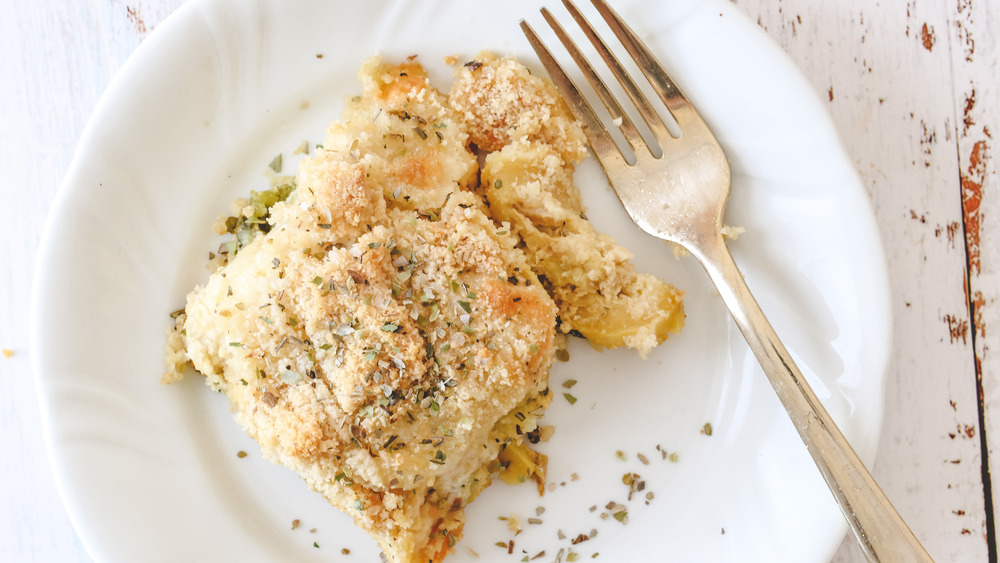
- 4 small yellow squash or zucchini, sliced (about 6 cups total)
- 1 small onion, diced
- 1 red bell pepper, diced
- 1 garlic clove, minced
- 1 tablespoon oil
- 2 eggs
- 2 balls fresh mozzarella or 1 1/2 cups low-fat mozzarella, grated
- ¼ cup low-fat sour cream
- ¼ cup Greek yogurt
- 1 teaspoon salt
- 1/2 teaspoon pepper
- 1 cup ground almonds or almond flour
- chopped parsley or cilantro, for serving
- extra Greek yogurt or low-fat sour cream, for serving
- Preheat oven to 400 degrees Fahrenheit. Oil or spray a casserole dish with cooking spray.
- Slice 4 small summer squash into rounds. Dice 1 small onion. Dice 1 red bell pepper. Mince 1 clove of garlic. If using fresh mozzarella, cut into slices.
- Preheat a large pan to medium heat. Add 1 tablespoon of oil. Add squash, onions, bell peppers, and garlic. Cook vegetables, stirring occasionally for 10 minutes, until they are tender and can be pierced with a fork. Remove from heat and set aside.
- In a large bowl, combine 2 eggs, 1/4 cup of low-fat sour cream, 1/4 cup of Greek yogurt, 1 teaspoon of salt, and 1/2 teaspoon of black pepper for the casserole filling. Whisk it all together.
- Add vegetables to egg mixture. Stir to combine.
- Transfer the squash mixture into the prepared casserole dish. Try to layer neatly. Top with mozzarella slices. Sprinkle with 1 cup of ground almonds, and a pinch each of salt and pepper.
- Cover casserole dish with aluminum foil or lid and bake in the oven at 400 degrees Fahrenheit for 20 to 25 minutes. Remove lid and broil for another 10 minutes to get that beautiful, bubbling cheesy crust.
- If desired, top dish with fresh parsley or cilantro, in addition to a dollop of Greek yogurt or low-fat sour cream. Serve immediately.
Nutrition
| Calories per Serving | 325 |
| Total Fat | 23.9 g |
| Saturated Fat | 7.5 g |
| Trans Fat | 0.0 g |
| Cholesterol | 87.8 mg |
| Total Carbohydrates | 12.2 g |
| Dietary Fiber | 3.9 g |
| Total Sugars | 6.1 g |
| Sodium | 598.0 mg |
| Protein | 17.8 g |

